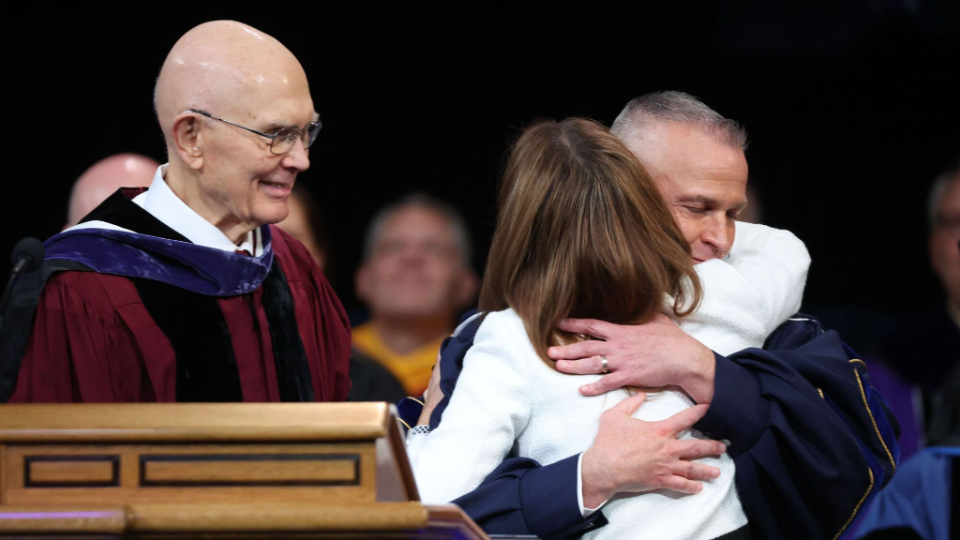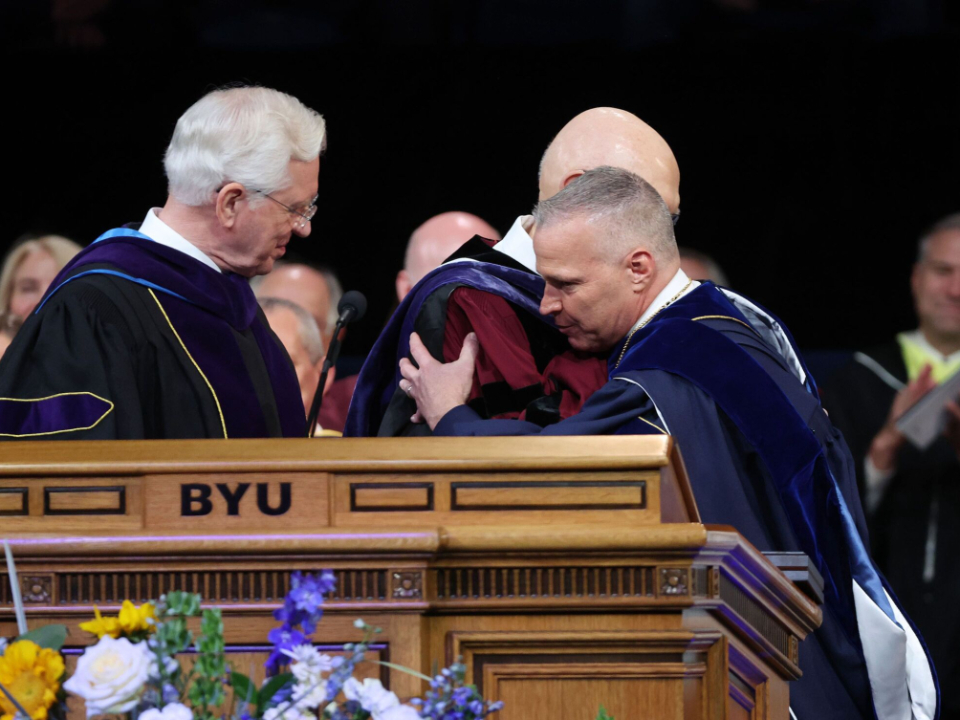
C.-Shane-Reese-Inauguration
BYU President C. Shane Reese hugs his wife, Wendy, after she placed the presidential medallion on him during his installation as BYU’s 14th president at the Marriott Center in Provo on Tuesday, September 19, 2023. President Dallin H. Oaks, First Counselor in the First Presidency of The Church of Jesus Christ of Latter-day Saints, looks on. Photo by Jeffrey D. Allred, courtesy of Church News.Copyright 2023 Deseret News Publishing Company.This story appears here courtesy of TheChurchNews.com. It is not for use by other media.
By Rachel Sterzer Gibson, Church News
President Dallin H. Oaks, First Counselor in the First Presidency, and Elder D. Todd Christofferson of the Quorum of the Twelve Apostles officially installed President Christopher Shane Reese as the 14th president of Brigham Young University on Tuesday, September 19.
During the late-morning installation held in the BYU Marriott Center and attended by Church, government, civic and education leaders, Elder Christofferson, chairman of the executive committee of the BYU Board of Trustees, charged President Reese to help the university become “what prophets past and present have foreseen it would become.”
With autumn colors just starting to fringe the edges of Y Mountain, BYU students, faculty and staff; members of the Quorum of the Twelve Apostles; and other General Authorities and General Officers filled the 19,000-seat Marriott Center to the topmost rows. The ceremony was also attended by Kevin J Worthen, BYU’s outgoing president, as well past presidents Elder Merril J. Bateman and Elder Cecil O. Samuelson. Elder Clark G. Gilbert, commissioner of the Church Education System, conducted the inauguration.
After Elder Christofferson’s invitation to President Reese’s wife, Wendy, to place the presidential medallion around the neck of her husband, the near-capacity crowd rose to their feet to energetically applaud the university’s new leader.

C.-Shane-Reese-Inauguration
BYU President C. Shane Reese smiles as he speaks during his installation as BYU’s 14th president at the Marriott Center in Provo, Utah, Tuesday, September 19, 2023. Photo by Jeffrey D. Allred, courtesy of Church News.Copyright 2023 Deseret News Publishing Company.Elder Ronald A. Rasband of the Quorum of the Twelve Apostles, who serves as vice chairman of the executive committee, began the ceremony by explaining the university’s unique and distinctive Board of Trustees.
An institution founded, supported and guided by The Church of Jesus Christ of Latter-day Saints, BYU’s board is led by the First Presidency, with the Prophet, President Russell M. Nelson, serving as chairman, President Oaks as first vice chairman, and President Henry B. Eyring as second vice chairman.
The charge given to President Reese during the installation outlines the “guidance and prophetic direction the board has for President Reese as he takes the helm of this university,” Elder Rasband explained. “This prophetic charge and BYU’s governance structure creates a tremendous advantage for BYU, its president, the work of its faculty and staff, and the spiritual development of these magnificent students. Indeed, it allows, in fact it compels, you to do things at this university that could be done nowhere else in the world.”
| Temple Square is always beautiful in the springtime. Gardeners work to prepare the ground for General Conference. © 2012 Intellectual Reserve, Inc. All rights reserved. | 1 / 2 |
President Reese’s Inaugural Charge
The board’s charge to President Reese as outlined by Elder Christofferson was six-fold. Besides helping BYU become “what prophets past and present have foreseen,” President Reese was also charged to be “the university’s chief moral and spiritual officer” and to teach and amplify the university mission with each member of the university community.
“Ensure that each understands and fully embraces this mission and can inspire others to be a light to the world even as they withstand the challenges of our day,” Elder Christofferson said. He also charged the new president to “help students and employees realize their divine identity as sons and daughters of God and as disciples of Jesus Christ who can lead in their families, the Church and their communities.”
Since BYU is first and foremost an undergraduate teaching institution, President Reese must elevate that core mission, Elder Christofferson continued. “You should likewise prioritize scholarship that is aligned with the purposes of the restored gospel of Jesus Christ and the mission of the Church.”

C.-Shane-Reese-Inauguration
BYU President C. Shane Reese hugs President Dallin H. Oaks, First Counselor in the First Presidency of The Church of Jesus Christ of Latter-day Saints, during his installation as BYU’s 14th president at the Marriott Center in Provo, Utah, Tuesday, September 19, 2023. Elder D. Todd Christofferson of the Quorum of the Twelve Apostles, left, looks on. Photo by Jeffrey D. Allred, courtesy of Church News.Copyright 2023 Deseret News Publishing Company.In conclusion, he charged President Reese to guide BYU in its prophetically inspired direction. “The board, with the Prophet at its head, will safeguard you through an increasingly challenging landscape, and point the way to academic and spiritual success.”
Both Elder Rasband and Elder Christofferson expressed their confidence and love for President Reese and his wife, Wendy Reese.
Like Esther of old, President Reese has been “raised up for such a time as this, a time where we contemplate the history of Brigham Young University as well as what prophets have asked this institution to become,” Elder Rasband said.
“We love you; we honor you, and we sustain you in this office. We look forward to serving with you,” Elder Christofferson told the new president.
President Reese’s Inaugural Response
In his response to the charges outlined by Elder Christofferson, President Reese commented that his primary qualifications for this sacred stewardship are a willingness to serve, an ability to work and a desire to learn.
“I love BYU and its mission. I love our students. They warm the world with their faith and brighten it with their light. I love my consecrated colleagues — faculty and staff — who labor tirelessly to make our inspired mission a reality for our students.”
President Reese said he is awed by the prophetic guidance given to this university by latter-day prophets. Church President Spencer W. Kimball articulated “a powerful roadmap” for the future of BYU, calling it “the greatest institution of learning in all the world.”
More recently, Elder Jeffrey R. Holland of the Quorum of the Twelve Apostles and past president of BYU taught that BYU will realize President Kimball’s vision “only to the degree it embraces its uniqueness, its singularity” and be “an undergraduate teaching institution that is unequivocally true to the gospel of the Lord Jesus Christ.”
The task of today is to claim the prophecies of the past, President Reese declared. “Our task is to become the university that prophets foretold — to become the world’s ‘greatest institution of learning’; ‘the fully anointed university of the Lord about which so much has been spoken in the past’; to become the BYU of prophecy and promise. This, then, is the challenge of our generation and the burden of my administration: Becoming BYU.”
Becoming BYU will require enriching the student experience and strengthening the university’s already student-centric approach as well as retaining a focus on undergraduate teaching, President Reese said.
Becoming BYU will require enriching the student experience and strengthening the university’s already student-centric approach as well as retaining a focus on undergraduate teaching, President Reese said.
Becoming BYU will also require “that we embrace our religious mission even as we speak to the broader academy with credibility and strength.”
Quoting President Kimball, President Reese noted that the faculty of BYU have a “double heritage — the preserving of the knowledge of men and the revealed truths sent from heaven.”
As BYU strives to become the university of prophecy, “we must develop ourselves in things both secular and sacred. When secular and sacred truths reinforce one another, we must embrace both. But when secular claims conflict with revealed truth, we must mark the difference.”
The university must also build a “covenant community,” invest in mission-inspired scholarship and engage in mission-aligned hiring.
Of the faculty, President Reese said, “These are the people that the Church, the academy, and the world look to for examples of faithful disciples who combine professional excellence with deep and abiding testimonies of the restored Gospel of Jesus Christ.”
As the president of BYU, President Reese pledged his “whole soul to helping us to become BYU. But this personal investment will come from the entire campus community as we lean in together to recruit, hire, and develop faculty who can lead this institution to its prophetic potential.”
For all who enter its doors, a BYU education should be spiritually strengthening, intellectually enlarging, character building, and it should lead to a life full of learning and service, President Reese said.
“This is a critical time in the history of Brigham Young University. Unfortunately, we work against a societal backdrop where discussion and dialog are being replaced by contention and monolog.”
As BYU embraces its unique institutional identity, it will foster a unique learning environment that will empower individuals to be peacemakers in an ever-more-divisive society. “Understanding our primary identities as children of God, children of the covenant, and disciples of Jesus Christ will permit us to ask questions and seek answers in ways that view the world and our disciplines through the lens of the restored gospel of Jesus Christ, rather than the vision-limiting view of the gospel through our disciplinary lens,” President Reese said.
Elder Paul V. Johnson of the Presidency of the Seventy and Relief Society General President Camille N. Johnson provided the invocation and benediction, respectively. The BYU Combined Choirs and the BYU Philharmonic Orchestra performed “All Creatures of Our God and King,” and “Come, Thou Fount of Every Blessing.”

